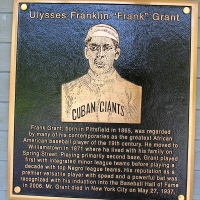Williamstown Honors Baseball Hall Of Fame Inductee Frank Grant
 |
| Plaque honoring former Williamstown resident and National Baseball Hall of Fame inductee Frank Grant. |
 |
| Plaque honoring former Williamstown resident and National Baseball Hall of Fame inductee Frank Grant. |
| If you would like to contribute information on this article, contact us at info@iberkshires.com. |